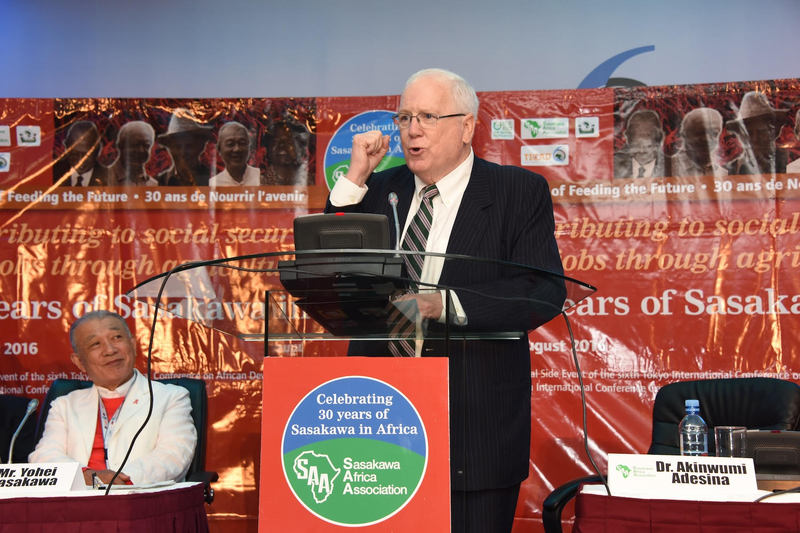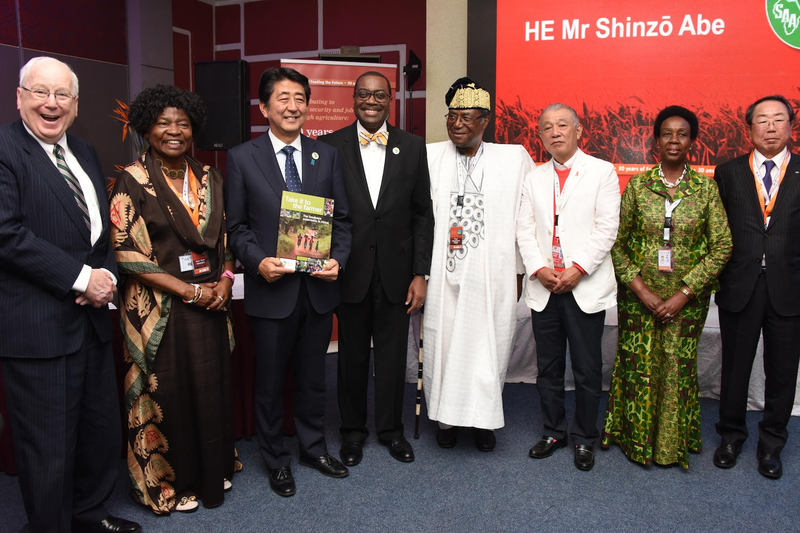Search
"The Inspiration of Norman Borlaug"
Remarks by: Ambassador Kenneth M. Quinn, President of the world Food Prize Foundation.
As Prepared for Delivery at the symposium celebrating the 30th Anniversary of the Sasakawa Africa Association held in conjunction with the TICAS VI Conference.
NAIROBI, KENYA - Mr. Yohei Sasakawa, Chairman of the Nippon Foundation, Professor Ruth Oniang'o, Chair of the Sasakawa Africa Association, Mr. Masaaki Miyamoto, Executive Director of the SAA, it is a great honor to have been invited to speak about the inspiration of Norman Borlaug, while joining in celebrating the 30th anniversary of Dr. Borlaug's first trip to Africa, with President Jimmy Carter, traveling at the invitation and urging of Ryoichi Sasakawa. My pleasure at being here is increased by the fact that this is also the 30th anniversary of my own first visit to Africa and to Kenya. This came when I accompanied U.S. Secretary of State George Shultz on the first ever trip to Africa by any American Secretary of State. A lot has changed in Kenya over those 30 years. But if the country can increase agricultural production the same way you have increased auto traffic in Nairobi, there is nothing to worry about.
 As we are gathered here as part of the TICAD VI conference, I want to begin with a tribute to Japan and the absolutely critical role that country has played in the entire Green Revolution. It was only with the development of Norin 10 semi dwarf wheat by Professor Gonjiro Inazuka in Iwate Prefecture that Norman Borlaug was able to develop his own miracle wheat in Mexico, the crop which he then took to India and Pakistan in the mid-1960s as those countries faced mass starvation. This became the start of the Green Revolution.
As we are gathered here as part of the TICAD VI conference, I want to begin with a tribute to Japan and the absolutely critical role that country has played in the entire Green Revolution. It was only with the development of Norin 10 semi dwarf wheat by Professor Gonjiro Inazuka in Iwate Prefecture that Norman Borlaug was able to develop his own miracle wheat in Mexico, the crop which he then took to India and Pakistan in the mid-1960s as those countries faced mass starvation. This became the start of the Green Revolution.
Secondly, we should pay tribute to the critical and catalytic role played by Ryoichi Sasakawa, whose vision for Africa and personal persistence brought Borlaug here in 1986 and which began this 30 year collaboration now so magnificently being carried forward by Yohei Sasakawa, SAA Chair Professor Ruth Oniang’o, and Executive Director Masaaki Miyamoto.
And, third, I want to make reference to the extremely impressive work in which I participated in the 1990s when Japan and the United States played such a powerful and collaborative leadership role in transforming Southeast Asia, and particularly Cambodia, from war to peace. At that time, Japanese development agencies put high priority on improving road infrastructure which has over the past 25 years turned the region into one of stability, integration and peace.
It is this emphasis on roads and rural infrastructure that also provided the linkages between Norman Borlaug and myself. When I first met him in 1999 as I was assuming leadership of the World Food Prize, I told Norm that I had worked in villages in the Mekong Delta in 1968, just when the Green Revolution was beginning and the first IR8 miracle rice was arriving. I added that I had observed that this new agricultural technological innovation was only used when the rural roads into the villages had been improved.
This combination of new roads and new rice brought immediate transformation to the villages where I was working. It was powerful in both uplifting families out of poverty, improving nutrition and overcoming local insurgent, guerrilla movements.
Borlaug, on hearing me say this, slammed his fist on the table and in a loud voice shouted “ROADS!!” I was startled and thought I was about to be fired from my new role heading the organization he had created to become the, "Nobel Prize for Food and Agriculture."
Instead, Borlaug reinforced my point saying that roads were absolutely essential. This has led to his famous quote, "If you want to feed Africa, build roads."
I told this same story to my dear friend His Excellency Akinwumi Adesina, the new president of the African Development Bank, when we first met in 2010 in Accra at the AGRA Forum. President Adesina, I know that Dr. Borlaug is looking down from Green Revolution heaven today with a big smile on his face, knowing that you have been elected to head the Bank. Your serving in this critical leadership position is one of the most important signs that Africa is truly poised for takeoff. You are uniquely qualified to bring together all of the essential elements of research and technology, policy development, and dramatically improved infrastructure, all with special emphasis on enhanced nutrition and the challenges of climate volatility.
Roads and infrastructure are equally important to building peace, as I stated in my World Food Day address to the United Nations in New York in 2013. The lessons from Southeast Asia to Afghanistan to Africa are clear: where the road ends, hunger, malnutrition and poverty, and conflict, terrorism and insurgency all begin. This is why the work of the Sasakawa Peace Foundation alongside the Sasakawa agricultural initiatives in Africa are so important.
Norman Borlaug's inspiration is threefold: first, his belief in the power of science and technology to increase yields and the availability of food; second, the importance of inspiring the next generation of young people; and third, the power of agricultural exchanges and coming together to confront hunger to build peace and understanding.
Those are the three missions of the World Food Prize that Borlaug established in May 1986, just five months after his first trip to Africa.
One of the best examples of agriculture bridging vast differences came in 2012 when the World Food Prize was awarded to an Israeli irrigation pioneer who had been nominated by three Arab scientists from three Muslim countries. His Excellency Ban Ki-moon, Secretary General of the United Nations, came to Des Moines to help present our prize to that Israeli, Jewish scientist, while a Muslim princess, an Arab Sheikh, and an Israeli diplomat stood together in the audience cheering.
I saw that same power to reach across vast differences when I traveled to Iran in 2014 to deliver the keynote address at a conference celebrating the 100th anniversary of the birth of Dr. Borlaug, organized by The Agricultural Biotechnology Research Institute of Iran. My proposal of cooperation to build understanding received a standing ovation from the Minister of Agriculture and the 400 Iranian scientists in attendance. Continuing this cooperation, I welcomed a leading Iranian scientist to Des Moines and for the last two years World Food Prize laureates have spoken in Iran. Marc Van Montagu in 2015; and Per Pinstrup-Andersen will arrive there this weekend.
This coming October, we will celebrate the 30th anniversary of the World Food Prize and we are greatly looking forward to welcoming leaders of the SAA to Des Moines as we present our $250,000 prize to four laureates, including two women and two African scientists, whose pioneering work in bio-fortification is uplifting the health and well-being of 10 million people across Africa and in up to 40 other countries around the world.
Furthermore, next week I will announce here in Nairobi the name of a young Kenyan scientist under the age of 40 who will receive our 2016 Borlaug Field Award, Endowed by the Rockefeller Foundation.
As we face the greatest challenge in human history, feeding 9 billion people in a world beset with terrorism and conflict and climate volatility, the legacies and inspiration of Norman Borlaug and Ryoichi Sasakawa, and the work of the Sasakawa Africa Association and the World Food Prize, along with the leadership of individuals like President Adesina, and so many others gathered here today, have never been more important.


